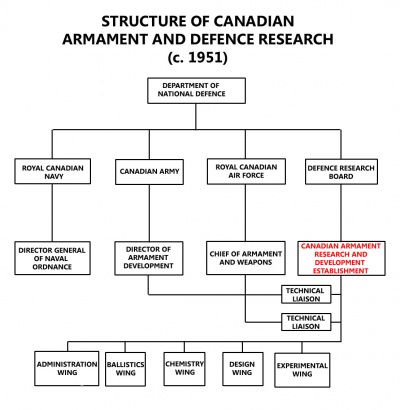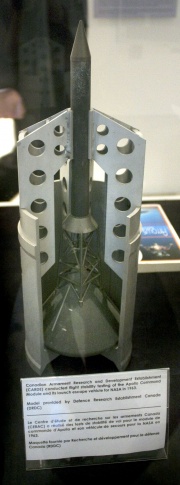Canadian Armament Research & Development Establishment
From The Space Library
At the beginning of World War II the Canadian National Research Council set up the Experimental Explosives Establishment (EEE) at Valcartier Quebec for manufacture of explosives and propellants. In 1942 the Internal Ballistics Research Laboratory (IRBL) was established for inspection and proof of ammunition and for quality control.
The IRBL was under the inspection of both the United Kingdom and Canada through an organisation known as IBUKAC. At the end of the war this became IBC (Inspection Board of Canada).
In March 1945 the EEE, IRBL and IBC merged to form the Canadian Armament Research and Development Establishment or CARDE, officially a branch of the Canadian Army.
The Defence Research Board came into existence on April 1st 1947 as a civilian agency and was responsible for scientific research for all three services but was not financed by the military budget. It also was expected to make its facilities and special capabilities available to civilian use.
In October 1947 CARDE came under the direct control of the Defence Research Board.
CARDE had five wings, Administration, Ballistics, Chemistry, Design and Experimental.
In the summer of 1947 CARDE budgeted for 74 scientists, 3 military officers, 339 support staff and 2 master gunners.
The first Chief Superintendent of CARDE was Dr. D.C. Rose a title which he retained until October 1947. Dr H. Poole of the British Ministry of Supply was instrumental in creating the initial mandate of CARDE.
Rose was followed by Dr W. Littler from the British Ministry of Supply at Waltham Abbey.
In 1950 CARDE began work on what would become the Velvet Glove air-to-air missile. Velvet Glove was to have been deployed in the CF-100 and CF-86 Sabres and then was assigned to the CF-105 but it would never be deployed. However the experience gained in Velvet Glove was put to good use and in 1954 CARDE created the Heller anti-tank missile. One of the most successful weapons of the next two decades.
In 1957 CARDE began work on anti-ballistic missile research. That same year an agreement was reached to work with the US Army Rocket and Guided Missile Agency.
The Black Brant sounding rocket, based on the British Skylark rocket, was developed at CARDE beginning in 1956 until its first static firing in February 1959.
In 1961-62 Climatic and environmental tests were conducted at CARDE on the Alouette satellite.
This would not be the only major space project at CARDE. In 1963 the aerodynamics of the Apollo Command/Service Module and Launch escape tower system were tested in ballistic firings of models at CARDE.
Much of the early ballistics work for Project HARP was conducted at CARDE.
CARDE is currently named Defence Research and Development Canada (DRDC) Valcartier.


